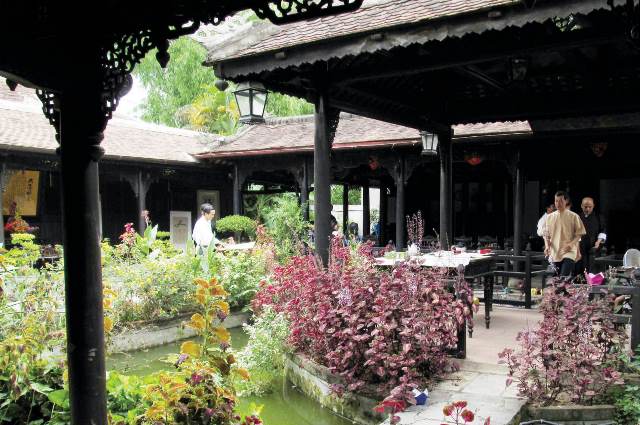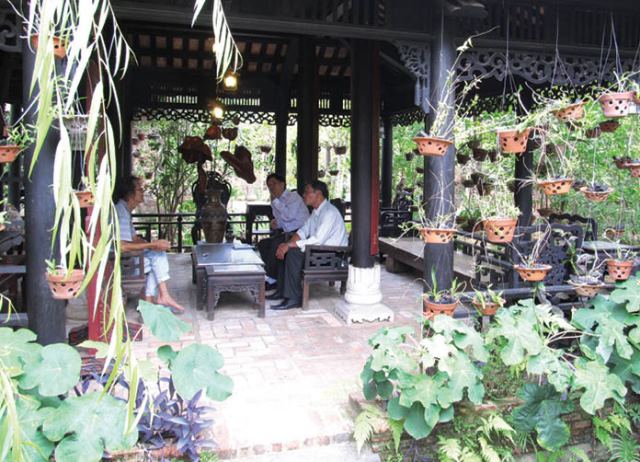
Part of Ngu Ha Garden
“Why living in misery like that?
Stopping at a shop selling pots and soil for flower growing on a street in the city center, I was both surprised and amazed at the fact that the shop owner still maintained such a large plot of land.
As common sense, many people now like to sell part of their land and use the money to renovate their houses or build another and invest in their business. Why taking pain to sell pots and fertilizer? How strange!
As if knowing what I was thinking, the shop owner grasped my hand and pointed at the beam house inside. “Look at my keeping of that house! It’s painstaking.”
I went from one surprise to another. I really did not expect to see behind the shop piled with goods was an ancient black wooden beam house shining up with time. I gave the thumbs up to express my admiration, then said goodbye, only to see his face brightening up with satisfaction.

The place for welcoming guests at Pham Ba Vinh’s beam house in Huong Long, Hue City
A few days later, in a conversation with a group of friends who liked growing orchids and ornamental plants, hearing me mention that shop and the beam house, one man said: "I know that house, but to be frank, I’m not very interested in it. The house looks low and dark with lots of columns inside. Keeping it free of spider webs is tiring to death. Why living in misery like that?”
Knowing I was talking to a man with a different perspective, I said nothing. Anyway, I understand it is a very popular idea now. Only those aged men with nostalgia like that kind of house.
Most people, especially young ones, prefer living in new, modern, and convenient houses. To them, beam houses are just for ancestry worshipping, but not a place to live because of its inconvenience.
I have a classmate whose family own a beam house. I remember visiting his house while his small sons were playing around. They chased each other, bumping into the columns screaming. Our conversation kept being interrupted. How inconvenient!
The beam house was costly then; how about selling it and building a modern house. I used to think so. But then in a meeting with Mr. Duong Dinh Vinh, an expert at reproducing beam houses, I changed my mind.
The living heritage should be conserved and adapted
Duong Dinh Vinh was so well known for collecting and reproducing beam houses that many people give him the nickname "King of nha ruong.” Besides working at the workshop in his house in Nguyet Bieu (Hue City), he was also invited to the North and the South to help restore and build many beam houses in many cities and provinces. Even very difficult people were pleased with his work.
In Hue, he owned a beautiful beam house named Ngu Ha Garden on Spring 68 Str. near Luong Y Bridge. That day, I met him at Ngu Ha Garden. Hearing me mention the small size and inconvenience of the traditional beam house, Vinh said: “Feel free to bring in modernity.” He had been applied his viewpoint very well and skillfully.
“As for columns, it’s because beam houses are usually small. Now if we widen them, they will become spacious and airy. Don't worry about breaking the "golden ratio" of the beam house. When the house is widened, columns and trusses must be bigger accordingly. The floor can be tiled; nothing wrong with that. Light colors not only make the house look clean, but enhance the beauty of wooden parts also. In the past, our ancestors didn’t do so because they didn’t have those materials. Building materials now are diverse. Then why not using them?”
“Even some constructions in the Imperial City such as Ngu Phung and Duyet Thi Duong, if you notice, are tiled. It was because the materials were imported from France. Then the toilet and modern equipment can be added to the beam house. Generally speaking, we can make traditional beam houses convenient,” said Vinh as if he were lecturing.
Because of his open view, some people asked him for advice on how to keep their traditional beam houses as worshipping places and how to design them properly. It is an appropriate way to conserve and adapt the beam house as living heritage.
More than that, Vinh even brought fine arts to the traditional beam house. For example, he hung lacquer paintings on suitable partitions. We should make the beam house not only traditional but also luxurious. That was what he had cherished. The pity is that he passed away while many of his good intentions had not been carried out.
To that shop owner, convenience or inconvenience did not matter. The more important thing was keeping the land and the beam house left for him by his ancestors.
In that house are many memories and values of the family. In the midst of this “market twister,” I think the man who keeps that beam house must possess a profound cultural background. I feel happy because of surprises that Hue people bring.
Story and photos: HIEN AN
